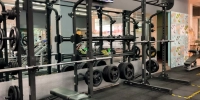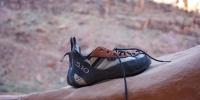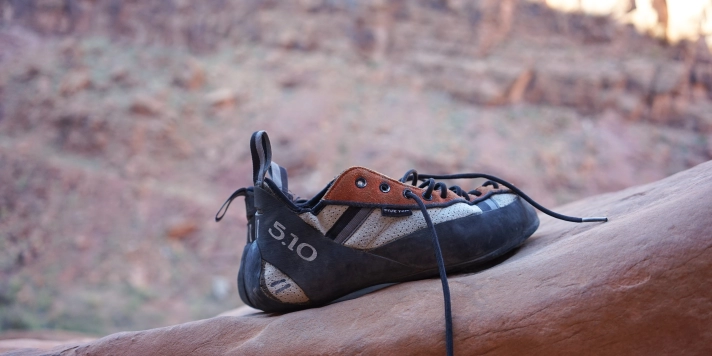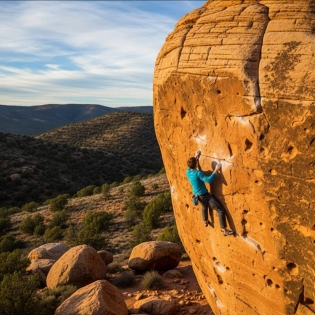








climbing shoes
No, it is not typical to wear socks with rock climbing shoes. Climbing shoes are designed to be worn without socks in order to maximize sensitivity and control on the rock. Wearing socks can create a barrier between your feet and the shoe, reducing the level of precision and feel. Additionally, socks can cause your feet to slide inside the shoe, leading to discomfort and potentially compromising your grip on holds. Most climbers prefer to wear climbing shoes directly on their bare feet to maintain the best connection and performance. However, if you have specific foot conditions or prefer to wear socks for hygiene reasons, you can look for thinner, low-profile socks specifically designed for climbing to minimize the impact on your climbing experience.
When wearing climbing shoes, it is common for your toes to be slightly curled. This helps in engaging the toe muscles and maximizing your ability to grip holds. The degree of curling may vary based on personal preference and the type of climbing you are doing. It's important to find a shoe that allows for a snug fit and provides enough toe curl to optimize your climbing performance while still maintaining comfort. Trying on different shoes and consulting with experienced climbers can help you find the right fit and level of toe curl for your climbing needs.
When it comes to buying climbing shoes, sizing preferences can vary among climbers. However, in general, it is not recommended to buy climbing shoes a size bigger. Climbing shoes are designed to provide a snug and precise fit, allowing for better control and sensitivity on the rock. Wearing shoes that are too large can lead to decreased performance and difficulty in accurately placing your feet on holds. It is important to find a balance between comfort and a snug fit. Many climbers prefer a snug fit that is slightly uncomfortable at first but molds to the shape of their feet over time. Trying on different sizes and brands, and consulting with experienced climbers or gear specialists, can help you find the right fit for your climbing style and personal preference.
There are a few signs that can indicate if your climbing shoes are worn out and need to be replaced:
- Sole Wear: Check the rubber sole for significant wear. If you notice a smooth or shiny patch in the middle of the sole, or if the edges are worn down, it's a sign that the shoes have seen better days. A worn-out sole can affect your grip and performance on the rock.
- Decreased Sensitivity: Over time, the sensitivity of climbing shoes can diminish. If you find it harder to feel the rock or accurately gauge your footholds, it might be a sign that the shoes have lost their sensitivity due to wear.
- Toe Box Deformation: Examine the shape of the toe box. If the rubber is excessively stretched or the toe box has become misshapen, it can affect your ability to accurately place your toes on small holds.
- Lining Damage: Inspect the lining of the shoes. If you see holes, tears, or excessive wear in the lining material, it can cause discomfort and reduce the overall lifespan of the shoes.
- Odor and Hygiene: If you've tried various methods to eliminate odor and maintain hygiene but your shoes still emit a persistent and unpleasant smell, it could indicate a breakdown in the materials of the shoes, making them less effective and less pleasant to wear.
The lifespan of climbing shoes varies depending on various factors such as frequency of use, climbing style, and personal preference. On average, a pair of climbing shoes can last anywhere from 6 months to 2 years. If you climb regularly, say a few times a week, you might expect them to last around 6 to 12 months. However, if you climb less frequently or take good care of your shoes, they may last closer to the 1 to 2-year range. It's important to monitor the condition of your shoes and replace them when the rubber sole wears down significantly or when they become uncomfortable or ineffective for climbing.
Best way to break in your shoes is to use them, this includes the heels and any other part of the shoe. Some areas might break in faster based on use, such as if you do a lot of heel hooks then the heel area of the shoe might break in faster.
Best bet is to climb in them as much as you can, just like breaking in the shoes in general, and to try and incorporate more heel hooks and heel specific movements. Either way, the heel will break in along with the rest of the shoe with more usage.
When do you feel your shoes are slippery? Is it when you are climbing on slabs, or in general when placing your foot on a hold even in an overhang?
I have a pair of shoes that feel extremely slippery, it's so bad that I have barely worn them for the past few years, they are basically new. They slip on almost every thing I try to stand on, regardless of if it's a slab or even a volume thats on a neutral flat wall. I thought maybe it was because of me not committing or trusting my feet (hence why I ask if it's only when you are climbing on slabs), but when I used my other shoes they stuck like magic.
The soles of my shoes are very smooth and hard, it feels almost like plastic in a way. I believe this is what is causing me to slip. My thought is to just send them in for either a resole (even though they are new and have no damage because I never wore them), or to get them roughened up a bit, I think there is a service for that as well.
The part of climbing shoes that stretches is typically the upper material. This is the part that covers the top of your foot and is responsible for providing a snug fit. The upper material of climbing shoes is often made of synthetic or leather materials, which have some elasticity. When you wear climbing shoes, especially during extended use, the upper material can gradually stretch to conform to the shape of your foot. This allows for increased comfort and improved performance while climbing. It's worth noting that not all climbing shoes stretch to the same extent, as it depends on the specific design and materials used by different manufacturers. Nonetheless, the upper part of climbing shoes is the primary area that tends to stretch over time.





